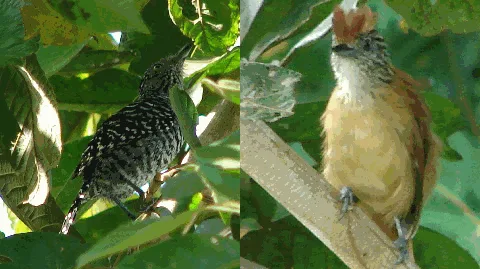
Barred Antshrike
[order] PASSERIFORMES | [family] Thamnophilidae | [latin] Thamnophilus doliatus | [UK] Barred Antshrike | [FR] Fourmilier pie-gieche barre | [DE] Binden-Wollrucken | [ES] Batara Barrado | [NL] Gebandeerde Mierklauwier
Subspecies
| Genus | Species | subspecies | Breeding Range | Breeding Range 2 | Non Breeding Range |
| Thamnophilus | doliatus | LA | widespread | ||
| Thamnophilus | doliatus | albicans | |||
| Thamnophilus | doliatus | cadwaladeri | |||
| Thamnophilus | doliatus | capistratus | |||
| Thamnophilus | doliatus | difficilis | |||
| Thamnophilus | doliatus | doliatus | |||
| Thamnophilus | doliatus | eremnus | |||
| Thamnophilus | doliatus | fraterculus | |||
| Thamnophilus | doliatus | intermedius | |||
| Thamnophilus | doliatus | nesiotes | |||
| Thamnophilus | doliatus | nigrescens | |||
| Thamnophilus | doliatus | nigricristatus | |||
| Thamnophilus | doliatus | pacificus | |||
| Thamnophilus | doliatus | radiatus | |||
| Thamnophilus | doliatus | signatus | |||
| Thamnophilus | doliatus | subradiatus | |||
| Thamnophilus | doliatus | tobagensis | |||
| Thamnophilus | doliatus | yucatanensis |
Physical charateristics
The Barred Antshrike is typically 16.5 cm long, and weighs 25 g. It has a yellow iris. The male is barred all over with black and white, and has a white-based black crest that is raised in display. The female is rufous above with a chestnut crest. The sides of her head and neck are streaked with black, and the underparts are rich buff. The Tobagoian race T. d. tobagensis is distinctive; males are whiter below, and females darker, than in the nominate subspecies.
Listen to the sound of Barred Antshrike
[audio:http://www.aviflevoland.nl/sounddb/B/Barred Antshrike.mp3]
Copyright remark: Most sounds derived from xeno-canto
| wingspan min.: | 0 | cm | wingspan max.: | 0 | cm |
| size min.: | 15 | cm | size max.: | 16 | cm |
| incubation min.: | 13 | days | incubation max.: | 14 | days |
| fledging min.: | 11 | days | fledging max.: | 14 | days |
| broods: | 1 | eggs min.: | 2 | ||
| eggs max.: | 3 |
Range
Latin America : widespread
Habitat
Understorey to midstorey of deciduous forest, second growth scrub, riparian scrub and forest along rivers. Ventures in to cultivated areas where it can be found in thickets, mangroves and gardens, usually found as territorial pairs. In Suriname a common bird in the coastal plane and savanna forest. It is the only Antshrike found in gardens in Paramaribo city.
Reproduction
Nest is a deep cup fastened by rim at a branch fork 1-9 meter above ground. Nest is built by both sexes of fine thread like matter like fungis, vines and moss. Also man made material is used like thread and strings. Clutch size is two purple-marked creamy white eggs, incubated by both sexes for 14 days to hatching. Only female incubates at night The chicks fledge in another 12-13 days. This species is often parasitized by the Shiny Cowbird.
Feeding habits
Feeds on ants and other arthropods at or near the ground, typically only ground dwelling when covered by overhanging vegetation. Also hitches hitching along trunks, gelaning insects. Sometimes follows columns of army ants, will take small lizards and berries.
Conservation
This species has an extremely large range, and hence does not approach the thresholds for Vulnerable under the range size criterion (Extent of Occurrence <20,000 km2 combined with a declining or fluctuating range size, habitat extent/quality, or population size and a small number of locations or severe fragmentation). Despite the fact that the population trend appears to be decreasing, the decline is not believed to be sufficiently rapid to approach the thresholds for Vulnerable under the population trend criterion (>30% decline over ten years or three generations). The population size is extremely large, and hence does not approach the thresholds for Vulnerable under the population size criterion (<10,000 mature individuals with a continuing decline estimated to be >10% in ten years or three generations, or with a specified population structure). For these reasons the species is evaluated as Least Concern.

Migration
Sedentary throughout range.
Distribution map

